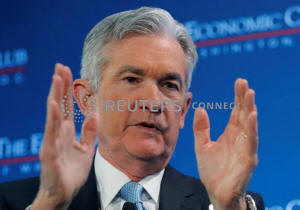|
Powell faces early reckoning on Fed's
$4-trillion question
 Send a link to a friend
Send a link to a friend
 [January 29, 2019]
By Jonathan Spicer and Ann Saphir [January 29, 2019]
By Jonathan Spicer and Ann Saphir
NEW YORK/SAN FRANCISCO (Reuters) - Federal
Reserve Chairman Jerome Powell has a problem: how to explain that the
Fed may soon begin to taper its ongoing asset-shedding operation without
looking like he's hunkering down for a coming recession, or caving to
U.S. President Donald Trump.
Not long ago, Powell expected to face this delicate communication test
some time later in 2019, rather than at his news conference on Wednesday
following the close of the Fed's first policy meeting of the year.
But three things - an unexpected scarcity of reserves deep in the
plumbing of Wall Street, overt public pressure from investors and the
White House, and the Fed's own decision to rethink its interest-rate
hikes - are forcing the U.S. central bank to acknowledge the real
possibility of hanging on to more bonds than originally planned.
"You cannot stop the rate-hiking cycle without communicating on the
balance sheet as well," said Thomas Costerg, senior U.S. economist at
Pictet Wealth Management, in Geneva, Switzerland.

A bigger balance sheet could result in an across-the-board easing of
market borrowing costs and the foreign-exchange value of the dollar,
easing strains on emerging markets. It could also affect the Fed's
appetite for bond buying in the face of a future U.S. downturn.
For more than a year, the Fed has methodically trimmed its
multi-trillion-dollar balance sheet - from nearly $4.5 trillion to about
$4.1 trillion and falling - without much notice.
Instead, it has kept the world's eyes trained on a series of
interest-rate hikes which, according to careful messaging from
policymakers in recent weeks, may have come to an end.
But late last year, prominent investors took to blaming the Fed's
balance sheet runoff for market volatility. To underline what they saw
as the harmful restraining effects of the Fed's reversal of its
bond-buying stimulus, the program known as quantitative easing
undertaken during the financial crisis to jump-start the economy, they
dubbed the runoff "quantitative tightening."
In December, Trump amplified that theme, tweeting that the central bank
ought not to "make yet another mistake" and "stop with the 50 B's" - a
reference to the $50 billion maximum in bonds by which the Fed has been
shrinking its portfolio each month, according to a plan it outlined and
began in 2017.
A day after the tweet, when Powell said the run-off remained on
"automatic pilot," the Standard & Poor's 500 stock index delivered its
worst 60-minute selloff in at least a year.
Two weeks later, when Powell stressed that the plan was actually
flexible, the index delivered its best 60 minutes in at least a year.
Trump's tweet exposed a dilemma for the Fed: though its 2017 plan
divorced balance sheet policy from monetary policy, markets see a
stronger connection. If the Fed is to stick to its guns on keeping the
balance sheet from becoming a first-responder tool against economic ups
and downs, Powell needs to keep that divorce on the books.

"I don't think they're going to stop," said Chuck Self, chief investment
officer at iSectors LLC, in Appleton, Wisconsin. "They want to get it
down as low as they can without disrupting the economy."
A CLEARER ROAD MAP
The central bank is indeed nearing the point at which it needs to adjust
its balance sheet plan, not because of the state of the domestic
economy, which appears strong, but because of the plumbing of short-term
markets.
[to top of second column]
|

U.S. Federal Reserve Board Chairman Jerome Powell participates in a
luncheon discussion hosted by the Economic Club in Washington, U.S.,
January 10, 2019. REUTERS/Jim Young/File Photo

As the portfolio has decreased, banks have trimmed the reserves they
keep at the Fed by even greater amounts, putting a strain on the
Fed's ability to control the short-term policy rate by which it
steers monetary policy.
Economists had already speculated last summer that to deal with
mounting scarcity of reserves, and the resulting upward push on
interest rates beyond a target range, the run-off would need to end
two years earlier and leave the Fed with $1 trillion more than it
had envisioned.
For its part, the Fed aims to trim its portfolio to an unspecified
level at which demand for reserves matches supply - though not to as
low as the $900 billion it held before the 2007-2009 recession
prompted it begin the purchases.
"It'll be substantially smaller than it is now...but nowhere near
where it was before," Powell said on Jan. 10, framing any decision
as a technical one and not a referendum on the overall policy
stance.
Growing questions about the balance sheet may prompt Powell to
sketch out a clearer road map for the asset holdings at his 2:30
p.m. (19:30 GMT) Wednesday news conference.
"They've got to get started on that," Darrell Duffie, a professor at
Stanford University's graduate school of business, said of
telegraphing the policy change. "They are not boxed in now, but the
longer they wait, the more boxed in they'll be."
After raising rates gradually last year, the Fed is taking a
wait-and-see approach to further tightening in the face of an
overseas slowdown and market volatility.
But even if rates remain steady this year, the ongoing shedding of
assets, including some $380 billion since October 2017, will
continue to tighten financial conditions by making funding more
expensive for banks.

In 2017, the Fed projected it would trim the portfolio until around
2022 when it would hold $2.3 trillion to $2.9 trillion in assets.
But minutes from the Fed's December meeting showed growing internal
debate with policymakers mulling holding a larger "buffer" of
securities than planned, or slowing the pace of run-off as the
finish line approaches.
In mid-2018, economists at Deutsch Bank Securities were among those
predicting the Fed would be forced to stop the process by early 2020
with about $3.7 trillion in assets.
The minutes, they wrote in a note, have "shifted the balance of
risks" even more and convinced them that Powell will move to halt
the portfolio run-off as early as the third quarter of 2019.
In a possible preview of Powell's message, New York Fed President
John Williams, a permanent voter on the Fed's policy-setting
committee, said on Jan. 18: "If circumstances change, I will
reassess our choices regarding monetary policy, including the path
of balance sheet normalization. Data dependence applies to all that
we do."
(Reporting by Jonathan Spicer and Ann Saphir; Additional reporting
by Trevor Hunnicutt; Editing by Leslie Adler)
[© 2019 Thomson Reuters. All rights
reserved.]
Copyright 2019 Reuters. All rights reserved. This material may not be published,
broadcast, rewritten or redistributed.
Thompson Reuters is solely responsible for this content. |